![]()
![]()
![]()
Use LEFT and RIGHT arrow keys to navigate between flashcards;
Use UP and DOWN arrow keys to flip the card;
H to show hint;
A reads text to speech;
13 Cards in this Set
- Front
- Back
|
discuss symmetry and ossicles |
- five rayed (pentameral) symmetry in many groups -internal mesodermal skeleton of porous calcite plates called ossicles ossicles can affect movement 1. sutured together 2. loosely sutured 3. imbricate - most flexible. |
|
|
what is the echinoderm skeleton like |
it is a box or sac-like body called a theca, calyx, test, or disk. |
|
|
what are the 3 classes of subphylum echinozoa |
1. Echinoidea - sea urchins, heart urchins, sand dollars 2. Holothuroidea - sea cucumbers 3. Stelleroidea - starfish and brittle stars all three classes are mobile, and represent Ordovician to Recent time period |
|
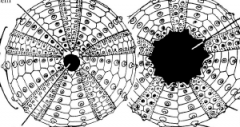
label dis |
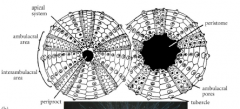
- globular test covered in short spines - calcite plates below the spiny layer -top is aboral, bottom is adoral |
|
|
compare regular and irregular echinoderms |
Regular: periproct in centre of apical disc (endocyclic). radial symmetry, typically live on sea floor. Irregular: periproct not in apical disc (exocyclic). bilateral symmetry, typically burrow - must maintain connection to SWI to breathe. - burrowers produce a very distinct trace called scolicia. |
|
|
what's the deal with flattened irregulars? (where do they live, feed, morphologic traits |
-live at or just below the surface - feed by sieving out fine detritus from sand - food grooves on adoral surface lined with tube feet - test covered in dense mat of fine spines. |
|
|
subphylum crinoidea. class? time? |
class - crinoidea - sea lilies M. Cambrian to Recent. |
|
|
label and draw a crynoid |
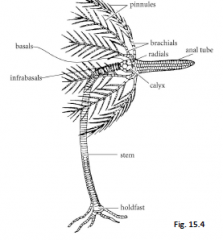
|
|
|
what does Rehophilic and Rheophobic mean |
Rheophilic (current seeking) - live in current swept waters, eat more and grow faster. Rheophobic (current avoiding) - rely on gravity to feed, eat less and grow slower. |
|
|
what is the relative timeline for crinoids, cystoids, blastoids, echinoids |

|
|
|
which bryozoans are low level epifaunal and which are high level epifaunal |
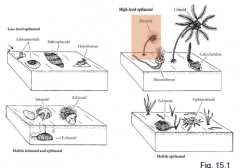
|
|
|
- Subphylum Blastozoa -Class Blastoidea - Blastoids -Silurian to Permian label a blastoid (may not be on test) |
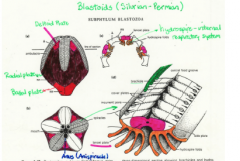
|
|
|
Subphylum Blastozoa Class Rhomberifera/Diploporita Cystoids age?morphology? lifestyle? |
-Cambrian to Devonian -globular flattened or elongate theca -irregularly shaped plates with pentameral symmetry -some with stems, others fixed to seafloor - lived in shallow water - tolerated some suspended sediment -pore systems may have been adapted for low oxygen |

